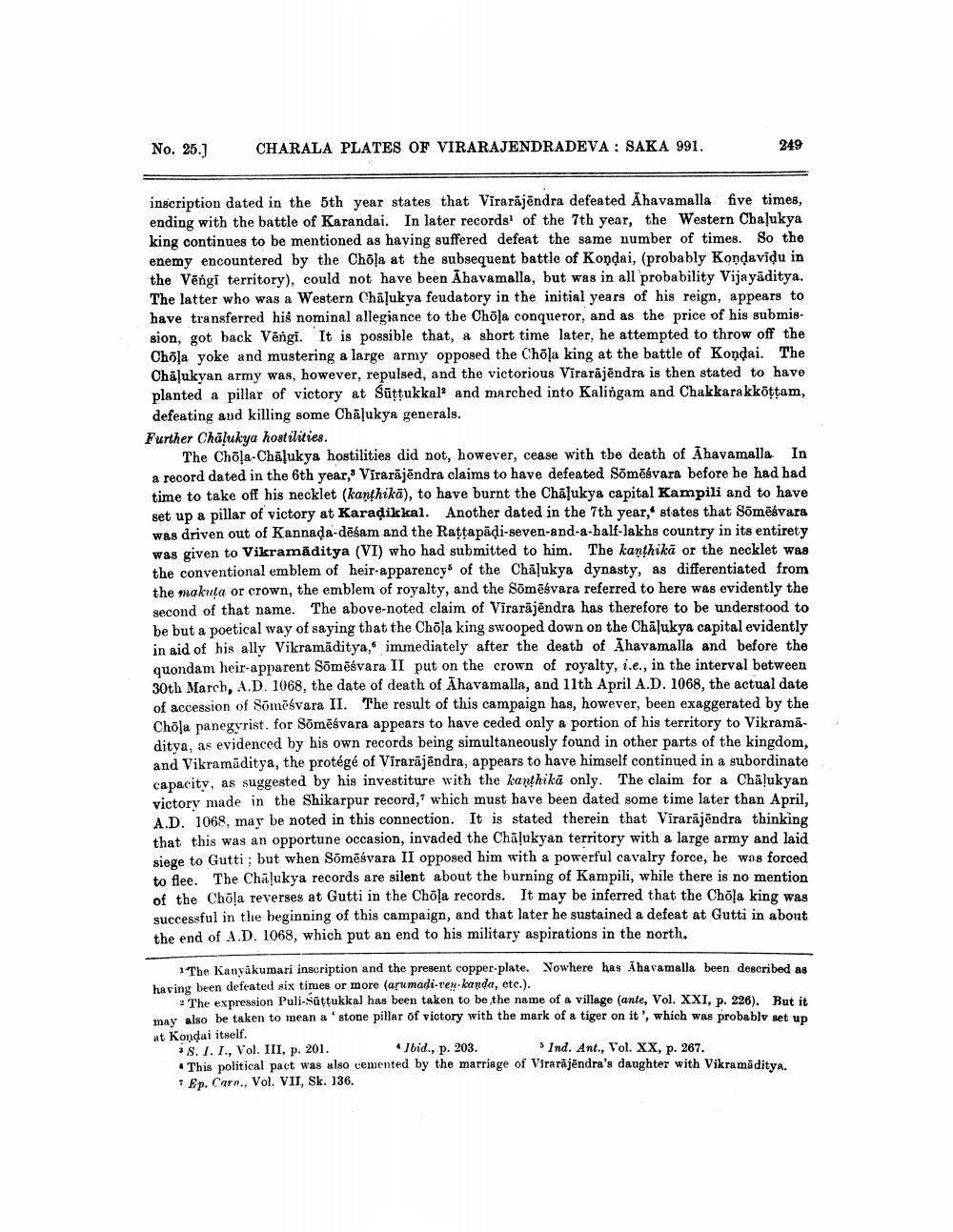________________
No. 25.)
CHARALA PLATES OF VIRARAJENDRADEVA: SAKA 991.
249
inscription dated in the 5th year states that Virarajëndra defeated Åhavamalla five times, ending with the battle of Karandai. In later records of the 7th year, the Western Chalukya king continues to be mentioned as having suffered defeat the same number of times. So the enemy encountered by the Chola at the subsequent battle of Kondai, (probably Kondavidu in the Vēngi territory), could not have been Āhavamalla, but was in all probability Vijayaditya. The latter who was a Western Chalukya feudatory in the initial years of his reign, appears to have transferred his nominal allegiance to the Chāļa conqueror, and as the price of his submission, got back Vēngi. It is possible that, a short time later, he attempted to throw off the Chõla yoke and mustering a large army opposed the Chola king at the battle of Kondai. The Chāļukyan army was, however, repulsed, and the victorious Virarājēndra is then stated to have planted a pillar of victory at Süttukkal and marched into Kalingam and Chakkarakköttam, defeating and killing some Chalukya generals. Further Chālukya hostilities.
The Choļa-Chalukya hostilities did not, however, cease with tbe death of Āhayamalla In a record dated in the 6th year, Virarājēndra claims to have defeated Sõmēsvara before he had had time to take off his necklet (kanthikā), to have burnt the Chalukya capital Kampili and to have set up a pillar of victory at Karadikkal. Another dated in the 7th year, states that Sömēsvara was driven out of Kannada-dēšam and the Rattapādi-seven-and-a-half-lakhs country in its entirety was given to Vikramaditya (VI) who had submitted to him. The kanthikā or the necklet was the conventional emblem of heir-apparency of the Chāļukya dynasty, as differentiated from the makula or crown, the emblem of royalty, and the Sömēsvara referred to here was evidently the second of that name. The above-noted claim of Virarājēndra has therefore to be understood to be but a poetical way of saying that the Chola king swooped down on the Chāļukya capital evidently in aid of his ally Vikramaditya, immediately after the death of Ahavamalla and before the quondam heir-apparent Sõmēśvara II put on the crown of royalty, i.e., in the interval between 30th March, A.D. 1068, the date of death of Āhavamalla, and 11th April A.D. 1068, the actual date of accession of Sõmēsvara II. The result of this campaign has, however, been exaggerated by the Chöja panegyrist for Sömēsvara appears to have ceded only a portion of his territory to Vikramā. ditya, as evidenced by his own records being simultaneously found in other parts of the kingdom, and Vikramaditya, the protégé of Virarājēndra, appears to have himself continued in a subordinate capacity, as suggested by his investiture with the kanthikā only. The claim for a Chāļukyan victory made in the Shikarpur record,' which must have been dated some time later than April, A.D. 1068, may be noted in this connection. It is stated therein that Virarājēndra thinking that this was an opportune occasion, invaded the Chāļukyan territory with a large army and laid siege to Gutti; but when Somēśvara II opposed him with a powerful cavalry force, he was forced to flee. The Chāļukya records are silent about the burning of Kampili, while there is no mention of the Chöļa reverses at Gutti in the Choļa records. It may be inferred that the Chola king was successful in the beginning of this campaign, and that later he sustained a defeat at Gutti in about the end of A.D. 1068, which put an end to his military aspirations in the north.
1 The Kanyakumari inscription and the present copper-plate. Nowhere has Ahavamalla been described as having been defeated six times or more (arumadi-ten-kanda, etc.).
The expression Puli sattukkal has been taken to be the name of a village (ante, Vol. XXI, p. 226). But it may also be taken to mean a' stone pillar of victory with the mark of a tiger on it, which was probably set up at Kondai itself. *S. I. I., Vol. III, p. 201.
Ibid., p. 203.
Ind. Ant., Vol. XX, p. 267. • This political pact was also cemented by the marriage of Virarājēndra's daughter with Vikramaditya. * Ep. Carn., Vol. VII, Sk. 136.




